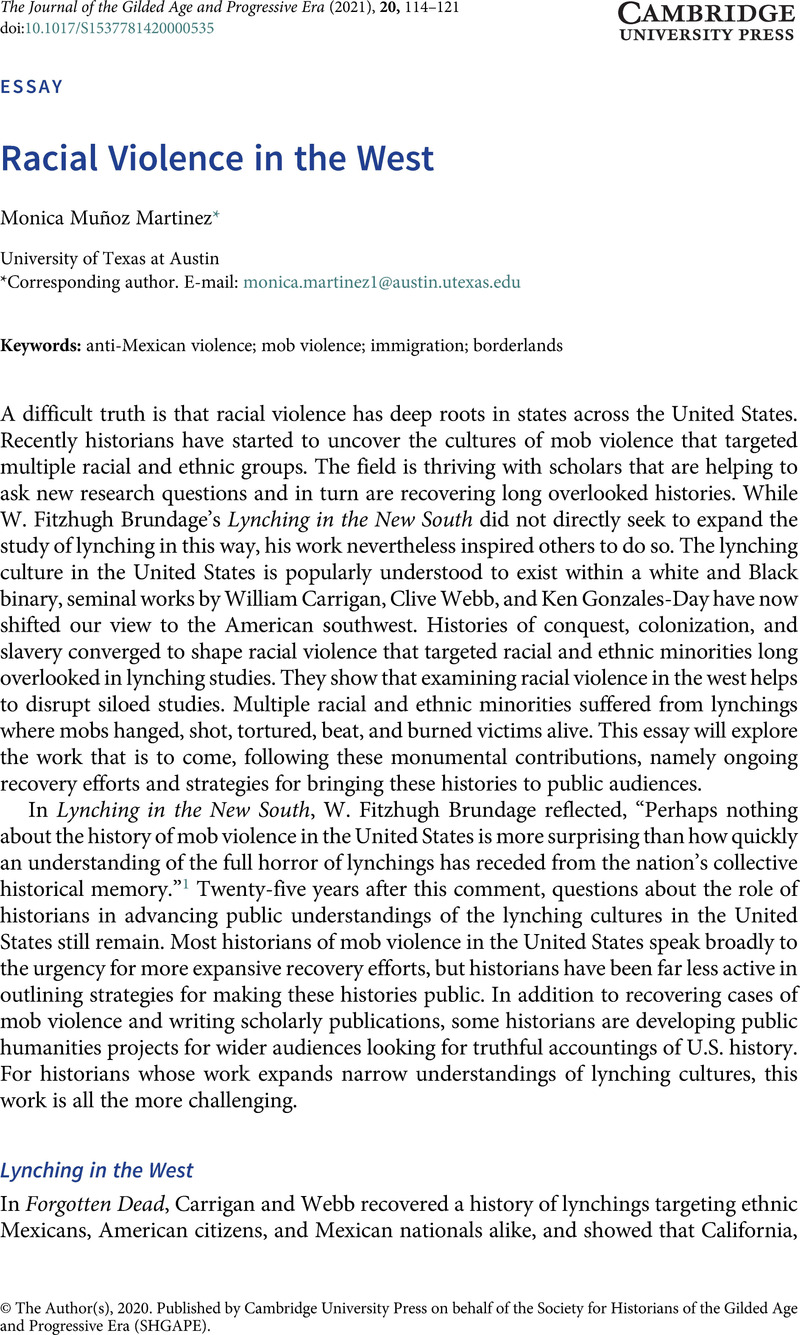No CrossRef data available.
Published online by Cambridge University Press: 01 December 2020

1 Brundage, W. Fitzhugh, Lynching in the New South: Georgia and Virginia, 1880–1930 (Urbana: University of Illinois Press, 1993). 258.Google Scholar
2 Carrigan, William D. and Webb, Clive, Forgotten Dead: Mob Violence against Mexicans in the United States, 1848–1928 (Oxford: Oxford University Press, 2013).Google Scholar
3 Carrigan and Webb, Forgotten Dead, 1.
4 Carrigan and Webb, Forgotten Dead, 4, 120–22.
5 For more on the Suaste case, see Carrigan and Webb, Forgotten Dead, 140–41, 155; Martinez, Monica Muñoz, The Injustice Never Leaves You: Anti-Mexican Violence in Texas (Cambridge, MA: Harvard University Press, 2018), 139–45.Google Scholar
6 Carrigan and Webb, Forgotten Dead, 7, 69–74.
7 Guidotti-Hernández, Nicole M., Unspeakable Violence: Remapping US and Mexican National Imaginaries (Durham, NC: Duke University Press, 2011), 85–86.Google Scholar
8 Annette M. Rodríguez, “Recognition of Social Murder: How Lynching the Invented ‘The Mexican’” (2016). American Studies Theses and Dissertations. Brown Digital Repository. Brown University Library, 30. https://doi.org/10.7301/Z0GH9GB8 See also Annette Rodríguez, “Antigone’s Refusal: Mexican Women’s Reponses to Lynching in the Southwest,” The Journal of South Texas, Spring 2018.
9 Gonzales-Day, Ken, Lynching in the West: 1850–1935 (Durham, NC: Duke University Press, 2006), 3.Google Scholar
10 Gonzales-Day, Lynching in the West, 200.
11 Gonzales-Day, Lynching in the West, 27–29, 135–36.
12 Gonzales-Day, Lynching in the West, 5–6.
13 Carrigan and Webb argue that while law enforcement officers in the American South did participate in mob acts, the leadership of the state police in Texas, the Texas Rangers, played such a prominent role in extralegal executions between 1915 and 1919 that the violence was something altogether different. The Rangers were “the blunt instrument of Anglos” in an era that some described as a “race war.” Carrigan and Webb, Forgotten Dead, 84–86.
14 Martinez, Monica Muñoz, “Mapping Segregated Histories of Racial Violence,” American Quarterly 70:3 (Sept. 2018): 657–63.CrossRefGoogle Scholar
15 Williams, Kidada E., “Regarding the Aftermath of Lynchings,” Journal of American History 101:3 (2014): 857–58CrossRefGoogle Scholar. In his survey of the field of lynching in 2014, Michael J. Pfeifer suggested, “Scholars might best focus their efforts by keeping the experiences and responses of the victims of the racially motivated mob violence (including African Americans, Hispanics, and Native Americans) at the fore of their inquiry, whatever that inquiry’s central concerns.”
16 Beth Lew-Williams, “Memorializing African American lynching victims is past due. But it must be only a start.” Washington Post, May 13, 2018.
17 Gonzales-Day, Lynching in the West, 182.
18 Monica Muñoz Martinez, The Injustice Never Leaves You, 227–29; 25–63; 272.
19 Saidiya Hartman, “Venus in Two Acts,” Small Axe, June 2008, 4–5.
20 Gonzales-Day, Lynching in the West, 204.
21 Pritchard, Linda K., “Exhibition Review: ‘Life and Death on the Border, 1910–1920, Bullock Texas State History Museum, Austin, Texas,’” Journal of American History 103:3 (2016): 711–15.Google Scholar